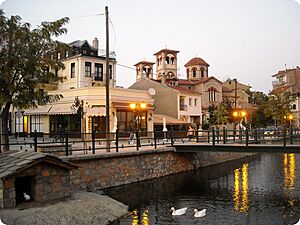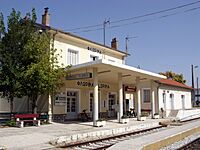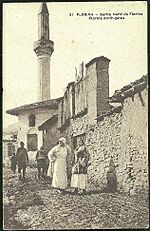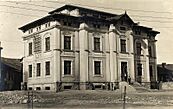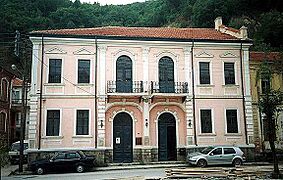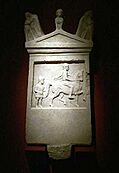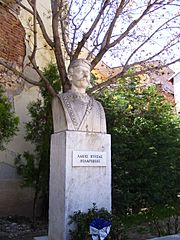Florina facts for kids
Quick facts for kids
Florina
Φλώρινα
|
||
|---|---|---|
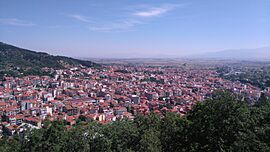
View of the city of Florina towards the NE
|
||
|
||
| Country | Greece | |
| Administrative region | Western Macedonia | |
| Regional unit | Florina | |
| Area | ||
| • Municipality | 819.7 km2 (316.5 sq mi) | |
| • Municipal unit | 150.6 km2 (58.1 sq mi) | |
| Elevation | 687 m (2,254 ft) | |
| Population
(2021)
|
||
| • Municipality | 29,500 | |
| • Municipality density | 35.99/km2 (93.21/sq mi) | |
| • Municipal unit | 19,198 | |
| • Municipal unit density | 127.48/km2 (330.16/sq mi) | |
| Community | ||
| • Population | 17,188 (2021) | |
| Time zone | UTC+2 (EET) | |
| • Summer (DST) | UTC+3 (EEST) | |
| Postal code |
531 00
|
|
| Area code(s) | 23850 | |
| Vehicle registration | ΡΑ* | |
| Website | http://www.cityoflorina.gr | |
Florina (Greek: Φλώρινα, Flórina; known also by some alternative names) is a town and municipality in the mountainous northwestern Macedonia, Greece. Its motto is, 'Where Greece begins'.
The town of Florina is the capital of the Florina regional unit and also the seat of the eponymous municipality. It belongs to the administrative region of Western Macedonia. The town's population is 17,188 people (2021 census). It is in a wooded valley about 13 km (8 mi) south of the international border of Greece with North Macedonia.
Contents
Geography
Florina is the gateway to the Prespa Lakes and, until the modernisation of the road system, of the old town of Kastoria. It is located west of Edessa, northwest of Kozani, and northeast of Ioannina and Kastoria cities. Outside the Greek borders it is in proximity to Korçë in Albania and Bitola in North Macedonia. The nearest airports are situated to the east and the south (in Kozani). The mountains of Verno lie to the southwest and Varnous to the northwest.
Winters bring heavy snow and long periods of temperature below freezing point. Furthermore, the town and the surrounding valley is usually covered in thick fog during the winter months that may last even for weeks under specific conditions. During the summer months it becomes a busy market town with an economy boosted by summer and, mostly, winter tourism due to the heavy snowfalls and the nearby ski resorts.
Even though Florina was the site of the first rail line built in the southern Ottoman provinces in the late 19th century, its rail system remains undeveloped. Today, Florina is linked by a single track standard gauge line to Thessaloniki and Bitola, and to Kozani (meter gauge) where it was intended to continue south and link up with the terminal in Kalambaka, in Thessaly but this did not proceed due to the 1930s financial crisis.
Florina is passed by GR-2 (Lake Prespa – Edessa) and GR-3/E65 (Kozani – Florina – Niki – Bitola). The new A27 motorway will run east of Florina with its Florina-Niki segment already operational since 2015. The historic Via Egnatia is situated to the east.
Climate
Florina is one of the coldest towns in Greece, because of its elevation and geographic position. Snowfalls, sometimes heavy, thick fog and below-freezing temperatures are common during the winter months, while the summers are warm to hot. Under the Köppen climate classification, Florina has a humid subtropical climate (Cfa), bordering on a humid continental climate (Dfa).
Cold wave of 2012
In the days preceding the early 2012 European cold wave, more specifically on 18 January 2012, a temperature of -25.1 °C was recorded by the HNMS's station with several reports, however, in the local press for temperatures in villages of the municipality that reached -32 °C, but there was no official record of such temperature. The National Observatory of Athens' station reported a temperature of -22.2 °C a day earlier in Florina, while the same station continuously recorded minimum temperatures below -20 °C from 16 January 2012 until 19 January 2012, with the average maximum temperature for January just -0.6 °C, and the prevalence for 13 consecutive days of temperatures below 0 °C 24 hours a day. The above situation resulted in the Greek General Secretariat of Civil Protection to declare the municipality of Florina in a state of emergency on 16 January 2012, at the request of the mayor of Florina, due to the polar temperatures and the intense snowfall that prevailed for days.
| Climate data for Florina (1961–2010) | |||||||||||||
|---|---|---|---|---|---|---|---|---|---|---|---|---|---|
| Month | Jan | Feb | Mar | Apr | May | Jun | Jul | Aug | Sep | Oct | Nov | Dec | Year |
| Record high °C (°F) | 18.7 (65.7) |
23.0 (73.4) |
25.8 (78.4) |
31.2 (88.2) |
33.8 (92.8) |
39.0 (102.2) |
40.8 (105.4) |
38.6 (101.5) |
36.0 (96.8) |
32.2 (90.0) |
26.6 (79.9) |
22.3 (72.1) |
40.8 (105.4) |
| Mean daily maximum °C (°F) | 4.7 (40.5) |
7.4 (45.3) |
12.0 (53.6) |
16.8 (62.2) |
22.0 (71.6) |
26.4 (79.5) |
29.0 (84.2) |
29.0 (84.2) |
24.7 (76.5) |
19.0 (66.2) |
12.2 (54.0) |
5.9 (42.6) |
17.4 (63.4) |
| Daily mean °C (°F) | 0.6 (33.1) |
2.8 (37.0) |
7.0 (44.6) |
11.7 (53.1) |
16.9 (62.4) |
21.1 (70.0) |
23.4 (74.1) |
22.8 (73.0) |
18.2 (64.8) |
12.9 (55.2) |
7.2 (45.0) |
2.0 (35.6) |
12.2 (54.0) |
| Mean daily minimum °C (°F) | −3.1 (26.4) |
−1.7 (28.9) |
1.5 (34.7) |
5.4 (41.7) |
9.5 (49.1) |
12.8 (55.0) |
14.8 (58.6) |
14.7 (58.5) |
11.4 (52.5) |
7.1 (44.8) |
2.6 (36.7) |
−1.8 (28.8) |
6.1 (43.0) |
| Record low °C (°F) | −25.1 (−13.2) |
−23.0 (−9.4) |
−13.6 (7.5) |
−5.0 (23.0) |
0.0 (32.0) |
2.4 (36.3) |
6.6 (43.9) |
4.0 (39.2) |
−1.4 (29.5) |
−5.0 (23.0) |
−12.6 (9.3) |
−18.6 (−1.5) |
−25.1 (−13.2) |
| Average precipitation mm (inches) | 56.8 (2.24) |
51.1 (2.01) |
57.8 (2.28) |
60.4 (2.38) |
59.4 (2.34) |
37.3 (1.47) |
33.9 (1.33) |
30.6 (1.20) |
50.1 (1.97) |
69.2 (2.72) |
71.3 (2.81) |
85.6 (3.37) |
663.5 (26.12) |
| Average precipitation days | 11.0 | 10.6 | 11.1 | 10.6 | 10.7 | 7.2 | 5.5 | 5.3 | 6.5 | 7.6 | 9.7 | 11.8 | 107.6 |
| Average snowy days | 7.5 | 6.3 | 4.5 | 0.8 | 0.0 | 0.0 | 0.0 | 0.0 | 0.0 | 0.3 | 1.8 | 5.9 | 27.1 |
| Average relative humidity (%) | 81.2 | 76.4 | 68.8 | 63.2 | 62.8 | 58.6 | 55.4 | 56.9 | 63.3 | 71.4 | 77.8 | 81.7 | 68.1 |
| Source: Hellenic National Meteorological Service | |||||||||||||
Name
The city's original Byzantine name, Χλέρινον (Chlérinon, "full of green vegetation"), derives from the Greek word χλωρός (chlōrós, "fresh" or "green vegetation"). The name was sometimes Latinized as Florinon (from the Latin flora, "vegetation") in the later Byzantine period, and in early Ottoman documents the forms Chlerina and Florina are both used, with the latter becoming standard after the 17th century. The form with [f] (φλωρός) is a local dialect form of χλωρός in Greek. The local Slavic name for the city is Lerin (Лерин), which is a borrowing of the Byzantine Greek name, but with the loss of the initial [x] characteristic of the local dialect. The Albanian name for the city is Follorinë. In Aromanian, it is Florina, while in both Bulgarian and Macedonian, it is Лерин (Lerin).
Municipality
The current municipality of Florina was formed at the 2011 local government reform by the merger of the following 4 former municipalities, that since 2011 became municipal units:
- Florina
- Kato Kleines
- Meliti
- Perasma
The municipality has an area of 819.698 km2, and the municipal unit 150.634 km2.
Municipal Unit subdivisions
The municipal unit of Florina is further divided into the following communities:
- Alona
- Armenochori
- Florina
- Koryfi
- Mesonisi
- Proti
- Skopia
- Trivouno
History
The ancient settlement of Melitonus was located in the area of Florina.
Within the boundaries of the present-day city lie the remains of a Hellenistic era settlement on the hill of Agios Panteleimon. Archaeologists excavated on the site in 1930–1934, but a hotel was later built over the ruins. Excavations began again in the 1980s and the total excavated area is now around 8,000 metres square. The buildings uncovered are mostly residential blocks, and the range of finds suggests that the site was continuously inhabited from the 4th century BC until its destruction by fire in the 1st century BC. Many of these finds are now on display in the Archaeological Museum of Florina.
The town with its present name is linked to the Byzantine Chloron. It is first mentioned in 1334, when the Serbian king Stefan Dušan established a certain Sphrantzes Palaeologus as commander of the fortress of Chlerenon. By 1385, the place had fallen to the Ottomans. An Ottoman defter (cadastral tax census) for the year 1481 records a settlement of 243 households.
Ottoman traveller Evliya Çelebi passed through Florina in the seventeenth century. He wrote Florina consisted of six neighbourhoods and had 1500 homes, one tekke, several mosques, madrasas and mektebs, two bathhouses and two inns. Under Ottoman rule, Florina was a regional economic and administrative centre, the seat of a kaza and belonged to a sanjak within the Vilayet of Monastir. Members of Filiki Eteria were the brothers Loukas Nedelkos and Nikolaos Nedelkos, who were born in the Florina region.
Florina and its inhabitants greatly contributed to the Macedonian Struggle. Prominent leaders included Nikolaos Pyrzas, and Petros Chatzitasis.
In the late Ottoman period the area surrounding Florina supported the Internal Macedonian Revolutionary Organization (IMRO) who fought against the Ottomans. During the Macedonian Struggle the Greek makedonomachoi gained significant advantage towards the Bulgarian Exarchists within 10 months in 1905 and extended their zone of control in various regions of western Macedonia including the plains north and south of Florina.
The Balkan Wars (1912-1913) brought an end to Ottoman rule when Florina and the surrounding area was taken by Greece during November 1912. Annexed by Greece, Florina became part of the Greek province of Macedonia. In 1916, Florina became a World War I battleground of the Macedonian front and was occupied by Bulgaria and later retaken by the French army. Many pro–Bulgarian people or Muslims of Florina and in nearby areas were shot by Greek irregular troops of the Entente following the French capture of the town.
Florina continued to be a multiethnic town following the Greek–Turkish population exchange, and as a consequence became a place with strict surveillance by the Greek state with cooperation from the local government and the Orthodox Church. In November 1925, known as the "Dynamite Attempt", Komitadjis attacked a coffee shop in Florina with a grenade injuring 2 children. Some perpetrators escaped to Albania, others were captured by Greek authorities and some locals allegedly involved were also arrested. During the Axis Occupation of Greece in World War II, Florina was under German control and the town became a centre of Slavic separatism.
For part of the Greek Civil War (1946–1949) the mountains of the Florina area were under communist control. The Slavic-Macedonian National Liberation Front, later simply the National Liberation Front or NOF, had a significant presence in the area: by 1946, seven Slav Macedonian partisan units were operating in the Florina area, and NOF had a regional committee based in Florina. When the NOF merged with the Democratic Army of Greece (DSE), many Slav Macedonians in the region enlisted as volunteers in the DSE.
In early February 1949, the Greek National Army and the Gendarmerie defeated an attempted takeover of Florina by the Greek communist Democratic Army of Greece. Communist casualties numbered 750-850 individuals and were all buried in a mass grave located in south-eastern Florina. When the Communists were defeated on 12 February 1949 by the Greek army thousands of communists and Slav Macedonians were evacuated or fled to Yugoslavia and the Eastern Bloc.
Transport
Rail
The city is served by Florina station on the Thessaloniki–Bitola line, with local trains to Thessaloniki.
Economy
Florina is a market town with an economy dominated by agriculture, forestry, summer and winter tourism, cross-border trading and the sale of local produce such as grain, grapes, and vegetables including Florina peppers. It also has textile mills and is known for locally manufactured leather handicrafts.
The most notable industrial activity is the very large Ptolemaia-Florina lignite mine.
Its university changed in 2002 from being a branch of the Aristotle University of Thessaloniki, to a part of the University of Western Macedonia. After 2004, four departments that previously belonged to the Aristotle University, reinforced its potential.
Florina has 8 radio stations, 2 daily political newspapers, 4 weekly ones, one women's press and two newspapers on sports.
During the 1950s and 1960s, the area lost much of its population to emigration, both to Athens and Thessaloniki as well as US, Canada, Australia and Germany. Following Greece's EU membership and the economic upturn, many from Germany returned.
In 2016 a new section of the A27 motorway was opened from Florina to the border with North Macedonia.
Landmarks
The Muslim community existed for five centuries in Florina and they constructed various public and religious buildings. The Ottoman architectural landscape of several mosques, two bathhouses, a clock tower and some Ottoman mansions persisted until the 1923 population exchange. There were seven mosques and all were demolished during the twentieth century. The first five mosques were demolished in 1926 by an order from the General Administration of Macedonia, the prefect of Florina and by the decision of the Municipal Council. The mosques of Florina were: Minare de Kapit mosque (destroyed), Minare Zantial mosque (demolished in 1928), Kursumli mosque or Minare Oso (destroyed), Minare Ouest mosque (destroyed) and another mosque (destroyed). In 1952, one mosque was still open in Florina. Carsi i Yakosu Bey mosque was built in the eighteenth century, the building and most of the minaret, excluding its base, were demolished between 1953-1954. Another destroyed building was the Tekke, where the site is the present location of the town's bank.
Other Ottoman era landmarks were the clock, located in the town centre and demolished in 1927; the Hamman (bathhouse), demolished in 1925 and the present site of the Papastefa house. The Muslim Cemetery was destroyed, as the early Greek administration implemented a new urban plan and later the large Muslim cemetery was expropriated in the north of Florina for the project. Another Hamman still exists, built at either the late sixteenth or early seventeenth century, it was in use until 1958 and in a poor state of preservation during the 2010s. The Koula, a fortification tower built either in the late eighteenth or early nineteenth century was part of a larger residential complex demolished in 1985, the tower remained but became dilapidated. Throughout the twentieth century, most Muslim monuments were destroyed and in the post 1960s reconstruction of Florina nearly all traces of the Muslim presence disappeared. Surviving Ottoman landmarks in a good state of preservation are the prison, built in the early twentieth century; and the administration building built in 1904 and later repurposed for Florina's courts following Ottoman rule.
After Florina became part of Greece, a new urban plan was undertaken by the government to modernise and Hellenise the town. Florina underwent change and sites or buildings associated with diverse past cultures and peoples such as mosques, synagogues and cemeteries disappeared. Post World War Two, there are no remaining traces of the Jewish cemetery in Florina. The Cathedral of St.Panteleimon was constructed in 1870 and Slavic architectural forms featured on its windows, three domes and an iconastasis with Slavic writing, later replaced with Greek writing. Over time modifications were made to the altar and windows. In 1971, the Cathedral was declared a hazard to public safety and demolished.
In Florina, a Bulgarian school was constructed between 1905-1908 by townspeople who were part of the Bulgarian Exarchate and it operated till 1913. Repurposed several times, it became a Greek high school twice and used in a military capacity by the French (WWI), Germans (WWII) and the Greek National Army (Greek Civil War). Later, it served as a Commercial School and the Economic High School (1961-1977). Earmarked for possible preservation by the government, the two-storey building was proposed to house the future Art Museum of Florina. Instead the school was demolished in late 1978 by the local municipal authority with support from Florina's Archbishop Kantiotis who opposed the building's Bulgarian Church origins. The site was rebuilt as a high school.
In early twenty first Florina, over 40 monuments exist in the town and include sculptures, statues, headstones, busts and other objects depicting or in reference to its history, in particular the struggle over Macedonia, the Second World War and the Civil War in Greece. There are twelve monuments of fighters such as Kapetan Kottas and politicians involved in the Macedonian Struggle placed mainly after 1960 in Florina to mark the success of Greek efforts over the Bulgarians. In the town square named George Modis, there are busts of Macedonian Struggle figure L. Pyrzas and the General I. Pappous of the National Army during the Civil War with a display of cannons taken from the Communists, the losing side in the conflict. These monuments were erected in an era when their visual presence and symbolism were used by the government as a way to assimilate the local multicultural inhabitants. Other town square monuments are the statue symbolising freedom and a memorial to Greek military casualties of the Greek Italian War (1940-1941). Florina has a military cemetery for fallen Greek soldiers from the Greek Civil War.
In the mid 2000s, two attempts to erect a memorial to communist fighters who died during the 1949 attempted takeover of Florina were vandalised and destroyed by unidentified individuals. The Greek Communist Party bought the site in 2009 and erected a memorial in 2016 encompassing several sculpted individuals on the field commemorating the fighters. In 2005, three marble reproductions of funerary monuments were placed in the town centre, the ancient Greek originals dating from Classical and Roman antiquity are displayed in the Florina Archaeological Museum. There have been some efforts by local people to showcase Florina's heritage from the Ottoman period and other less highlighted or neglected parts of the town's past through an exhibition, a documentary film and a scholarly lecture. Some of these initiatives have also attempted to highlight past practices of censorship and received various responses with some local support or opposition.
- Archaeological Museum of Florina
- Florina Museum of Modern Art
- The Florina Art Gallery
- Folklore Museum of the Aristotle Association
- Folklore Museum of the Culture Club
Demographics
Under Ottoman rule, Florina's population included Muslims, Greeks, Jews, Slavophones and Romani.
Austrian diplomat Johann Georg von Hahn visited the city in 1861 and wrote about it in his travel log From Belgrade to Salonica. In it he writes that "[a]bout the houses in Florina, we should indicate that there are at most 3,000, with half of the population Albanian and Turkish Muslims and the other half Christian Bulgarians." According to an 1878 French ethnographic book Florina was a town of 1,500 households, inhabited by 2,800 Muslims and 1,800 Bulgarians.
In 1896 traveller Victor Bérard visited Florina and stated it had 1,500 houses composed of Albanians and "converted Slavs", with 100 "Turkish" families and 500 Christian families. Bérard wrote "these Slavs nonetheless call themselves Greek and speak Greek—with us at least", while in Florina a few hundred were Bulgarian supporters and the Ottoman administration in the area was pro–Bulgarian. Journalist H. N. Brailsford was in Macedonia in the aftermath of the Ilinden Uprising (1903). He wrote Florina's Greek bishop spoke in Turkish to the church congregation as they were "Bulgarians", while the town was viewed as Greek because it remained attached to the Patriarch.
A Jewish Sephardi community was present in Florina during the 17th century. Under Ottoman rule, the Jews of Florina had close ties with the Jewish community of Monastir (modern Bitola). Romani people migrated from Anatolia to Florina. In the mid to late 1910s, some Florina Romani migrated to Elbasan and Korçë and compose most of their urban modern Romani populations.
According to historian Tasos Kostopoulos, after Florina became part of Greece, its population numbered 10,000 with two thirds being Muslim. Many Christian inhabitants of Florina were Slavic speakers with the remainder composed of 30 Aromanian families and 89 Greek refugee families from Thrace and Asia Minor. Florina Christians supported the Greek cause and the Bulgarians were aware that more than half were "Grecomans".
Efthymios Boudonas, a Public Education Office director and former school general inspector for Macedonia wrote (1914) Florina was a non–Greek speaking town incapable of linguistically hellenising its inhabitants or any non–Greek speaking newcomers, although it had a strong Greek faction. In 1916, Greek diplomat Nikolaos Politis wrote Florina had a total population of 10,392 composed of 6,227 Muslims, 3,576 Greeks and 589 former Exharchists.
Philologist André Mazon was in Florina and the wider area doing research in 1917-1918 and 1920. Florina had a total of 10,000 people. Mazon wrote Florina was populated by Turkicized Albanians and Christian Slavs, split almost evenly between 9000 inhabitants, with the remainder consisting of Greeks, Aromanians and Jews who had recently arrived from Bitola after its 1917 destruction. Much of the Christian population remained Patriarchists, even during the period of the Exarchate, with some becoming Hellenised and apart from a few exceptions they spoke (Macedonian) Bulgarian in their homes.
Following the Balkan Wars (1912-1913), the large Aromanian community in Monastir (modern Bitola) was disappointed that the city became part of Serbia and they migrated to Greece. Many went to Thessaloniki and others settled in Florina, where in the late 1920s a new neighbourhood was established named Agia Paraskevi with a population of 600 refugee Aromanian families. The arrival of many hellenised Aromanians from Monastir to Florina resulted in the establishment of a large Greek speaking population in the region. During the First World War, 60 Jewish families resettled in Florina after they left Monastir in 1916 to avoid the shelling of the city, later some other Monastirli Jewish families also went to live in Florina after the war.
The 1920 Greek census recorded 12,513 people in the town, and 4,650 inhabitants (1,076 families) were Muslim in 1923. Muslim Albanians from Florina and the wider region during the Greek–Turkish population exchange (1923) based on religious criteria were sent to Turkey, and mainly resettled in Bursa. Following the Greek–Turkish population exchange, Greek refugee families in Florina were from East Thrace (79), Asia Minor (54), Pontus (7) and the Caucasus (44) in 1926. The 1928 Greek census recorded 10,585 town inhabitants. In 1928, the refugee families numbered 178 (750 people) and the Jewish community numbered 500 people. The town remained multiethnic and continued to have Slavophones, Jews and Romani after the population exchange.
Local Jews were involved in the textile, agricultural and raw material sectors of Florina's economy. Florina was occupied in World War Two and Jews came under German rule. The Jewish community numbered 400 people in 1940. During April 1943, 372 Florina Jews were sent by the Germans first to the Hirsch ghetto in Thessaloniki and later in May sent to the Auschwitz concentration camp where they were gassed. In 1945, the Florina Jewish community numbered 64 people, a reduction of 84 percent due to the Holocaust. The Jewish population declined and by 1959 there were 7 Jews in Florina, 1 in 1973 and 0 in 1983.
The Romani of Florina are sedentary and in 1968 they converted from Islam to Orthodoxy. In the modern period, Florina Romani have distanced themselves from their relatives in Elbasan and Korçë, over concerns that links with Muslim Romani could negatively impact their local standing in the area they reside.
During the late twentieth century, Florina numbered some 15,000 inhabitants. Its population was composed of Slavophone Dopii, the Greek Anatolian refugees from the Greek–Turkish population exchange and their descendants, Greeks who had recently left the former Soviet Union, Aromanians and Hellenised Aromanians from Bitola who went to Florina in 1913, Romani, Albanians, and a small number of foreigners.
In fieldwork done by Riki Van Boeschoten in late 1993, the population of Florina is mixed and Greek is often the language used for communication. Minority languages are used in the town, especially on market days when farmers from the villages arrive in Florina to sell their produce. The Romani community of Florina speak Romani and are multilingual in all other languages used in the region. Van Boeschoten estimated the Romani numbered some 3000 in Florina, living in a neighbourhood on the town's environs.
The Centre for the Macedonian Language in Greece is based in Florina.
| Year | Town | Municipal unit | Municipality |
|---|---|---|---|
| 1981 | 12,573 | - | |
| 1991 | 12,355 | 14,873 | - |
| 2001 | 14,985 | 17,500 | - |
| 2011 | 17,907 | 19,985 | 32,881 |
| 2021 | 17,188 | 19,198 | 29,500 |
Notable people
- Alexis Alexoudis (born 1972), footballer
- Mary Coustas (born 1964), Australian actor
- Necati Cumalı (1921–2001), Turkish novelist, short–story writer & poet
- Peter Daicos Australian Football player (AFL); family from Vevi, Florina region
- Dimitrios Makris (1901–81), Member of Parliament & Minister
- Pericles A. Mitkas (born 1962), electronic & computer engineer, Aristotle University of Thessaloniki rector
- Nikolaos Pyrzas (1880–1947), leader during the Macedonian Struggle
- Nadia Tass (active 1979 to present), Australian director & actor
- Pavlos Voskopoulos (born 1964), politician & leader of the Rainbow party
- Elpida Karamandi (1920–1942), partisan fighter
Gallery
-
House in Florina. Scenery of Angelopoulos film O Melissokomos
See also
 In Spanish: Flórina para niños
In Spanish: Flórina para niños




